The James Rose Center
506 East Ridgewood Avenue
Ridgewood, NJ 07450
Phone: (201) 446-6017
Email: http://www.jamesrosecenter.org
Fee: Adults $8.00/Children $5.00
Open: Tuesday-Sunday-10:00am-4:00pm/Closed Mondays
TripAdvisor Review:

Originally designed as his own home, today the James Rose Center serves as the headquarters of a non-profit educational foundation, the mission of which is to improve the environment through research, education, preservation and design.

I recently toured the James Rose House with members of the Ridgewood Historical Museum. We had a lecture on the house and James Rose’s work in the industry as an architect and the other projects he had worked on over the years before his death in 1991.

James Rose House at 506 East Ridgewood Avenue
The lecture was followed by a tour of the house with the group and then a small lecture and tour with the guide. We got to see the whole house, what he was trying to achieve in the design and the renovation work on the house as it is in pretty bad shape. The materials that were used to build the house were not the best quality and have rotted over the years. There is a lot of restoration work on the house that is needed.

We were able to walk all around the house and what struck me was the use of nature in the design of the house. He used the trees and brook on the property to achieve the aesthetic of the design of the house but over the years it has been used against it as the trees have either grown too big around the house or have died, in which one did and caused thousands of dollars of damage on the house. Still, it was an interesting tour of how the house was used as a studio and a family home for him, his mother and unmarried sister.

History:
James Rose (1913-1991) was a maverick landscape architect whose rebellious nature caused one writer to refer him as the “James Dean of Landscape Architecture.” Here Rose created a unique work of art fusing modern sculpture, architecture and landscape into a single unified place for living.

(Information from the Center’s pamphlet)
For its unique modern spatial language, its expression of an alternative approach to conventional post war suburban residential development and as the constantly changing laboratory of one of landscape architecture’s most inventive minds, the Ridgewood home of James Rose is one of the twentieth century’s most important landscapes.
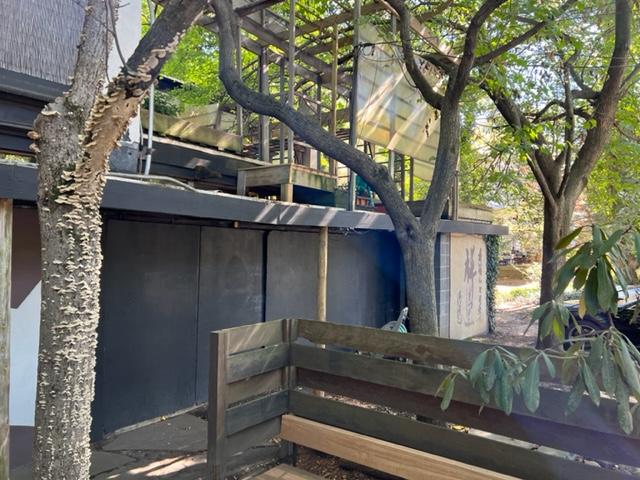
The Front of the house

The Vision:
Rose began the design while in Okinawa during World War II with a model he made from scrapes found in construction battalion headquarters. “I wanted the spaces flowing easily from one to another, divided for privacy and for convenience.” Rose wrote in 1943. “I wanted the arrangement flexible and varied. Most of all, I wanted all this integrated with the site in a design that seemed to grow, to mature and to review itself as all living things do.”
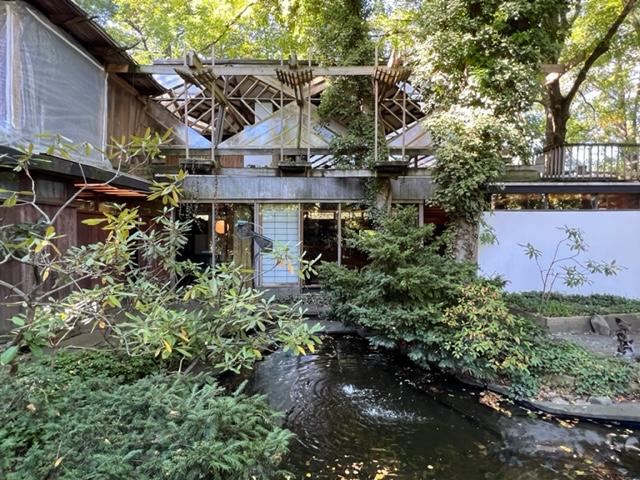
The Reality:
Constructed in 1953, Rose described his home as a “tiny village” build on an area half the size of a tennis court. It was a composite of three buildings-a main house for his mother, a guesthouse for his sister and a studio for himself. This experimental landscape achieves a fusion of indoors and outdoors perhaps unequaled by other leading designers of this time. Rose later described it as “neither landscape nor architecture, but both; neither indoors, nor outdoors but both.”

The Metamorphosis:
It was conceived to accommodate rapid twentieth century charge. “I decided to go at the construction as you might a painting or sculpture.” Rose wrote. “I set the basic armature of walls and roofs and open spaces to establish their relationships but left it free in detail to allow for improvisation. In that way it would never be “finished,” but constantly evolving from one stage to the next-ametamorphosis,” Rose wrote, “such as we find commonly in nature.”
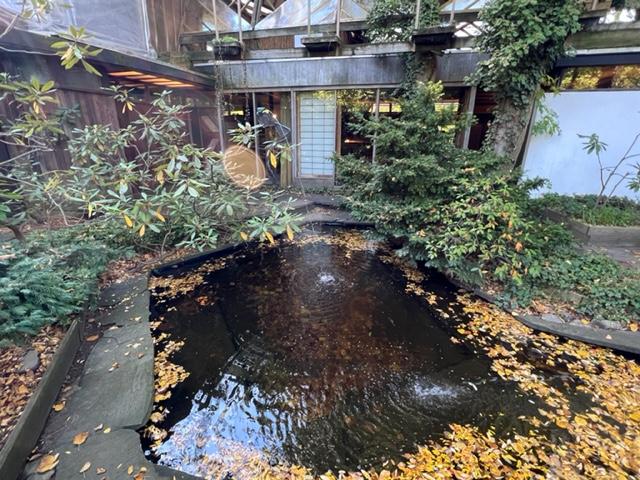
Consistent with this, the design changed dramatically during the almost forty years Rose lived here. From 1961, when Rose was invited by the Japanese government to participate in a World Design Conference (WoDeCo), he founded a mirror to his modern American design sensibility in the ancient culture of Japan. In changes such as the addition of the roof garden and zendo in the early 1970’s a fusion of ancient East and modern West is effected as Rose compares the filigrees of plant forms to the filigrees of structure. “In the bare architecture outline is a pattern of organic (rather than cosmetic) decoration and an inter division of space.”

The Reincarnation:
Unfortunately in the eighties this remarkable design, built to accommodate rapid growth went into rapid disrepair. Neglect, fire and water damage threatened complete destruction until a foundation was established by Rose, Dean Cardasis and a few of Rose’s close friends was formed just before Rose’s death in 1991. In 1993 the rehabilitation of this important property began and continues to this day. The site serves students, scholars and the general public in its new life as the James Rose Center for Landscape Architectural Research and Design.
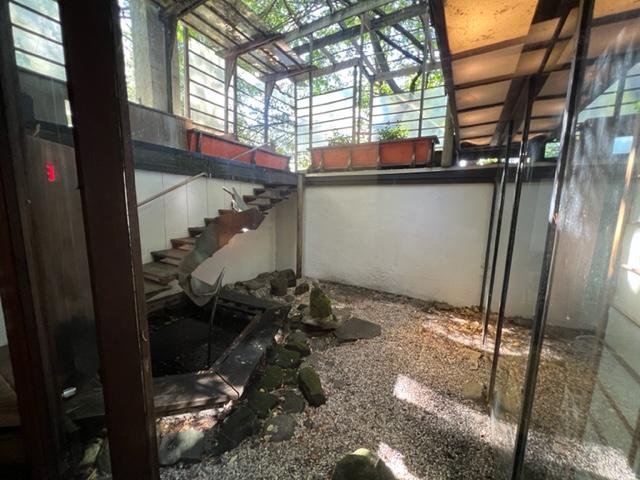
The rehabilitation reversed rampant deterioration of the previous decade. Support systems were revamped. Fire damage was repaired. The leaking roof was rebuilt and Rose’s roof garden was reconstructed. Salvageable wood was reconditioned and woven with new lumber. Garden pools were rebuilt and important planting edges re-established. Murals and other original artwork were reconditioned. Through the center’s ongoing efforts, Rose’s enduring creation has entered a new stage of its metamorphosis from which it will continue to evolve.

But it remains consistent with its origins as a important modern work and serves the same larger purpose it always had for Rose to pose for us elemental questions about the nature of design. “Change is the essence,” Rose observed. “To reveal what is always there is the trick. The metamorphosis is seen minute by minute, season by season, year by year. Through this looking glass, ‘finish’ is another word for death.”

(Ridgewood-James Rose Center History)
James Rose, landscape theorist, author and practitioner
Along with Garrett Eckbo and Dan Kiley, James C. Rose was one of the leaders of the modern movement in American landscape architecture. Rose was only five years old when his father died and with his mother and older sister, moved to New York City from rural Pennsylvania. He never graduated from high school (because he refused to take music and mechanical drafting) but nevertheless managed to enroll in architecture courses at Cornell University. A few years later he transferred as a special student to Harvard University to study landscape architecture. He was soon expelled from Harvard in 1937 for refusing to design landscapes in the Beaux Arts manner.

The design experiments for which he was expelled served as a basis for a series of provocative articles expounding modernism in landscape design, published in 1938 and 1939 in Pencil Points magazine (now Progressive Architecture). Subsequently Rose authored many other articles, including a series with Eckbo and Kiley as well as four books which advance both the theory and practice of landscape architecture in the twentieth century.

Rose was employed briefly in New York City in 1941 as a landscape architecture by Tuttle, Seelye, Place and Raymond where he worked on the design of a staging area to house thirty thousand men to Camp Kilmer, New Jersey. For a short time, Rose had a sizable practice of his own in New York City but he quickly decided that large-scale public and corporate work would impose too many restrictions on his creative freedom and devoted most of his post WWII career to the design of private gardens.
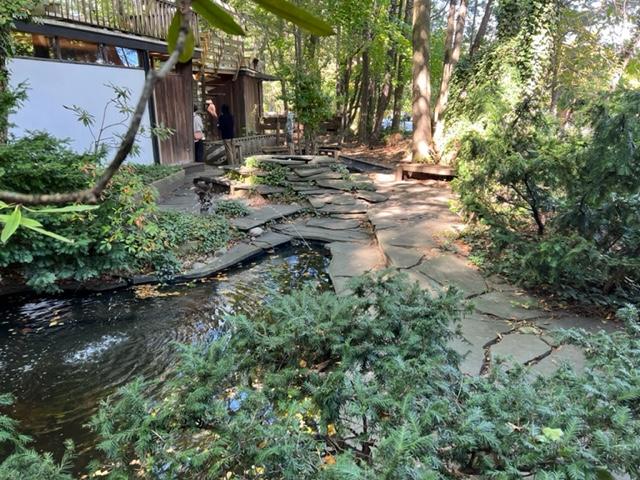
Fusion of indoor and outdoor space:
In 1953, he began building one of his most significant designs, the Rose residence in Ridgewood, New Jersey. Rose conceived of the design while stationed in Okinawa, Japan in 1943. He made the first model from scraps found in construction battalion headquarters. After construction, the design was published in the December 1954 issue of Progressive Architecture, juxtaposed to the design for a traditional Japanese house built in the garden of the Museum of Modern Art in New York City; the article cites Rose’s design for its spatial discipline. The design clearly expresses Rose’s idea of fusion between indoor and outdoor space as well as his notion that modern environmental design must be flexible between indoor and outdoor space as well as his notion that modern environmental design must be flexible to allow for changes in the environment as well as in the in the lives of its users.

Practice based on improvisation:
From 1953 until his death, Rose based an active professional practice in his home. Like Thomas Church and many others. Rose practiced a form of design/build because it gave him control over the finished work and allowed him to spontaneously improvise with the sites of his gardens. As a result of this, most examples also exist in Connecticut, Florida, Maryland, California and abroad.

.
Establishment of a landscape research and design study center:
James C. Rose was one of the most colorful figures in twentieth century landscape design. While skeptical of most institutions during his lifetime he served as guest lecturer and visiting critic at numerous landscape architecture and architecture schools. Before he died he set in motion an idea which had been in his mind for forty years; the establishment of a landscape research and design study center and created a foundation to support the transformation of his Ridgewood residence for this purpose. Rose died in his home in 1991 of cancer.

(James Rose Foundation-James Rose Center)
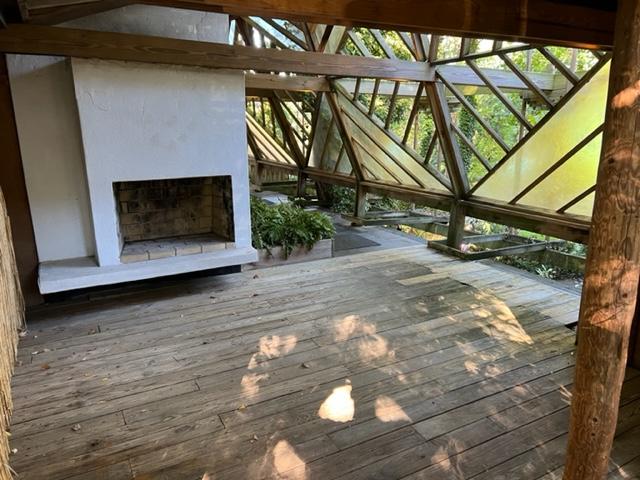
The upper part of the house.

The upper part of the house

The upper floors and garden

The upstairs near Ridgewood Avenue
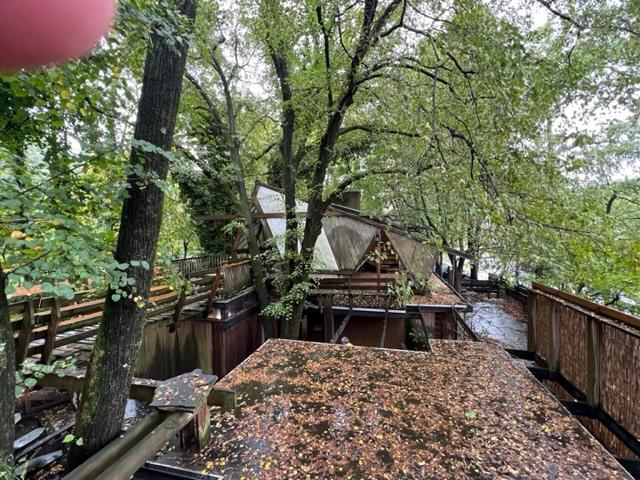
The upstairs of the house.


You have to really look for the house when visiting Ridgewood, NJ. I had passed it many times not knowing it was there.
LikeLiked by 1 person
Don’t miss the wonderful lectures that the James Rose Foundation puts on in the Fall months.
LikeLiked by 1 person